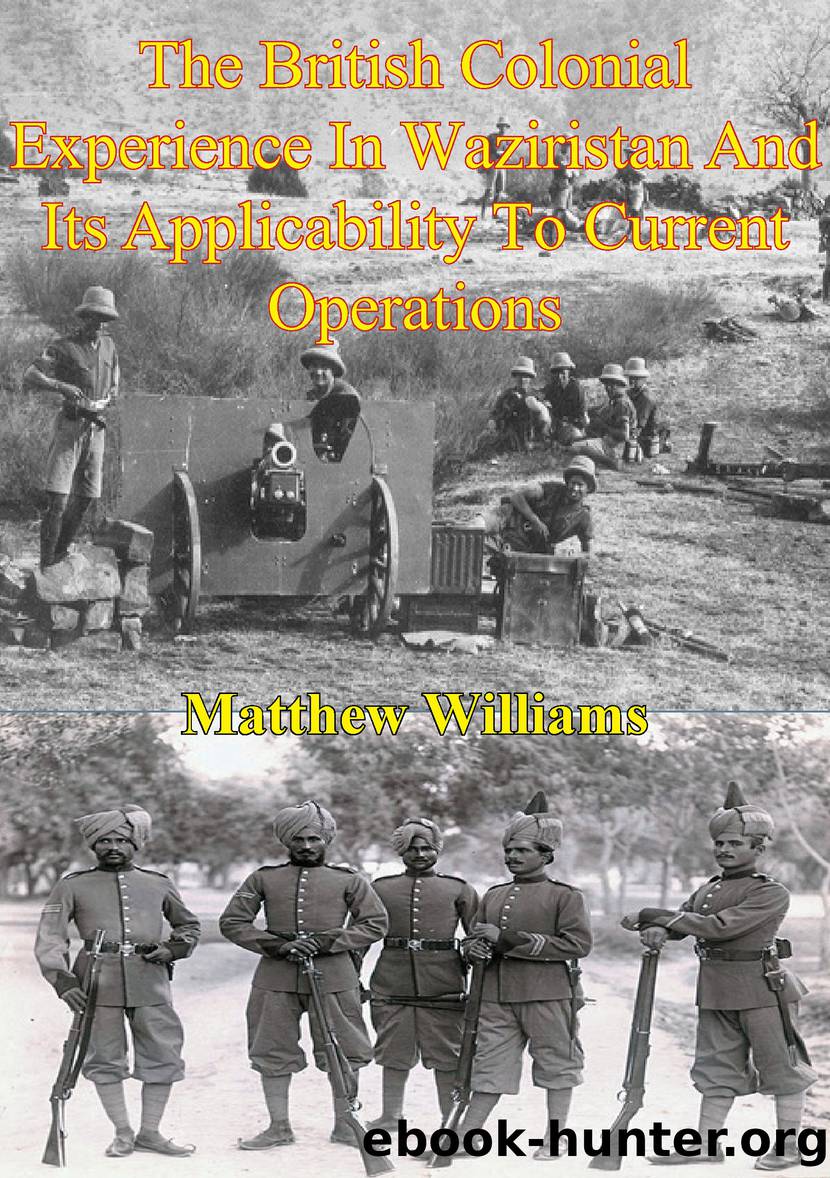The British Colonial Experience In Waziristan And Its Applicability To Current Operations by Williams Matthew;

Author:Williams, Matthew;
Language: eng
Format: epub
Tags: Monograph Preparation
Publisher: Tannenberg Publishing
Published: 2015-10-13T00:00:00+00:00
CHAPTER 4 â Current political realities in Pakistan
To understand how the British colonial experience relates to current realities in Waziristan, it is critical to understand the overall political system in Pakistan first. A complete examination of the complex political realities in Pakistan is outside the breadth of this monograph. It is possible, however, to gain an appreciation for the factors which shape the political landscape in Pakistan by briefly examining its structure and its primary actors. To best understand the current political realities in Pakistan, one must examine the overall structure of the government, the 1999 coup, the career and influences of the current President, the conflict in Kargil, and the other actors who shape politics in Pakistan.
Pakistan is the product of the division of India following independence from the British in 1947. Pakistan currently consists of four provinces, one territory, and one capital territory. Baluchistan, Punjab, Sindh, and the North-Western Frontier Province are the four provinces while the Federally Administered Tribal Areas and Islamabad represent the territory and capital territory respectively. Pakistan has a population of approximately 157 million persons and a per capita income of $460.
Pakistan has been governed poorly. Since its independence in 1947, the country has experienced internal strife, little rule of law, high crime, corrupt leadership, and poor governance at all levels. Pakistan is a semi-authoritarian state led by a powerful executive and has been governed by the military in thirty of its fifty-seven years of existence. It also has a bi-cameral Parliament and a constitution.
The current President, Pervez Musharraf, took power via a military takeover in October 1999. He removed the Nawaz Sharif government in a bloodless coup. Musharraf assumed the role of Chief Executive and continued to serve as the Chief of Army Staff and Chairman of the Joint Staff Committee. He also suspended Parliament and the constitution. He ousted Nawaz because the Prime Minister planned to arrest and eventually exile him. The coup followed eleven years of chaotic rule by Benazir Bhutto and Nawaz, both put in power by democratically elected political parties. The Supreme Court in Pakistan validated the coup in May 2000 but ordered Musharraf to hold general elections within three years.
Musharraf formally became President in June 2001 and dissolved the suspended Parliament. In a suspect referendum in April 2002, Musharraf s Presidency was extended until 2007. Parliamentary elections took place in October 2002 and a month later convened for the first time since the coup. In January 2004, Musharraf won a vote of confidence in the Parliament and four provincial assemblies.
To best understand the political realities in Pakistan, it is critical to understand Musharraf and his rise to power. His professional associations and religious orientation have significantly influenced his career progression. These factors have not only shaped his career but have an influence on the decisions he makes today. Those decisions directly affect U.S. policy in Pakistan in general and Waziristan specifically.
Musharraf is a Mohajir, a Muslim refugee from India. He was born on August 11, 1943 in New Dehli, India.
Download
This site does not store any files on its server. We only index and link to content provided by other sites. Please contact the content providers to delete copyright contents if any and email us, we'll remove relevant links or contents immediately.
The Vikings: Conquering England, France, and Ireland by Wernick Robert(79937)
Ali Pasha, Lion of Ioannina by Eugenia Russell & Eugenia Russell(40158)
The Conquerors (The Winning of America Series Book 3) by Eckert Allan W(37149)
The Vikings: Discoverers of a New World by Wernick Robert(36923)
Cecilia; Or, Memoirs of an Heiress — Volume 1 by Fanny Burney(32437)
Cecilia; Or, Memoirs of an Heiress — Volume 2 by Fanny Burney(31873)
Cecilia; Or, Memoirs of an Heiress — Volume 3 by Fanny Burney(31857)
Empire of the Sikhs by Patwant Singh(22978)
The Secret History by Donna Tartt(18853)
Hans Sturm: A Soldier's Odyssey on the Eastern Front by Gordon Williamson(18488)
Cat's cradle by Kurt Vonnegut(15189)
Pimp by Iceberg Slim(14398)
Sapiens: A Brief History of Humankind by Yuval Noah Harari(14256)
Talking to Strangers by Malcolm Gladwell(13231)
Norse Mythology by Gaiman Neil(13211)
Leonardo da Vinci by Walter Isaacson(13189)
4 3 2 1: A Novel by Paul Auster(12289)
Underground: A Human History of the Worlds Beneath Our Feet by Will Hunt(12027)
The Radium Girls by Kate Moore(11930)
